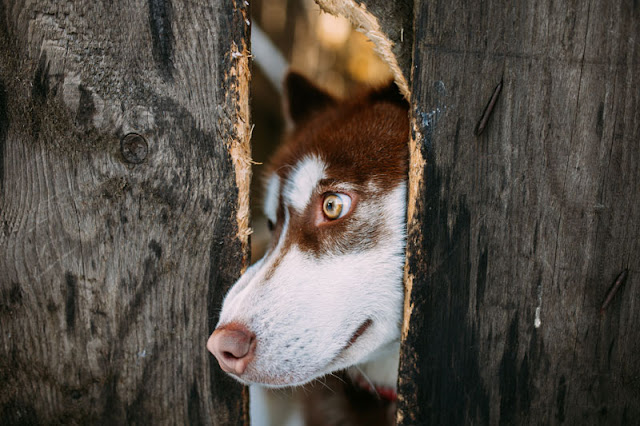How do Hand-Reared Wolves and Dogs Interact with Humans?
Dogs and hand-reared wolves react differently to approaches from a person, shedding light on domestication.
By Zazie Todd, PhD
By Zazie Todd, PhD
The question of how dogs evolved from wolves is complicated,
but it is clear there are important differences that could arise from genetics,
domestication, experience, or a combination of these. A study just published by Marta Gácsi in
Budapest investigates whether dogs and hand-reared wolves behave the same during
a changing social situation with a human.
Gácsi et al suggest several possible explanations of the wolves’ behaviour, including “that wolves did not consider this test as representing a conflict or competitive situation. Thus, their gaze-averting behaviour may be due to their ignorance of the human’s behaviour or their general tendency to avoid human gaze”. However, looking away and sniffing the ground during the threatening approach could be interpreted as displacement signals (Handelman, 2008). Also, since the wolves’ behaviour did change, it suggests they were not ignorant of the human behaviour after all.
Of the nine dogs that could be persuaded to join in the game, six showed guarding behaviour by barking at the experimenter and one also growled. When the game ended, all of the dogs let the human take her belt bag back. This shows flexibility, because they ceased their aggressive display.
During the object and food guarding, the Malinois growled or barked at the human. However they all allowed the human to retrieve her bag or bone later. It’s also worth noting that some of them gave the bag to their owner or the experimenter before guarding it. During the guarding situation, most of the dogs made a high-pitched noise, usually just before they began guarding.
The wolves that took part in the study were hand-reared by
humans from birth, spending the first few months of their life in a house with
their caregiver. The wolves attended dog training (usually puppy class) while
young. Now they live at a wolf park but are regularly visited by their
caregivers, and take part in experiments and other activities such as education
programs. Thus, the wolves are highly socialized and accustomed to human
contact.
In the first experiment, 13 wolves and 13 pet dogs took
part. They were put on a lead and tied to a tree, so they had some freedom of
movement but could not escape. Their owner or caregiver stood passively nearby.
The unfamiliar experimenter first made a friendly approach to the animals. This
was followed by a threatening approach to all but one animal (a wolf who had
not responded well to the friendly approach). Finally the experimenter made
sure that things ended well by calling the animals to her and petting them if
they had been disturbed by the threatening approach.
The results showed that all of the dogs and most of the
wolves responded to the friendly approach in either a passive or friendly
manner. Dogs wagged their tails, and many wolves licked the experimenter’s face
or hand. With the threatening approach, the dogs were significantly more likely
to look at their owner than the wolves. This ties in with another study (Gácsi et al 2013) which found that owners have a ‘safe haven’ effect for dogs when a threatening stranger approaches.
Five of the pet dogs barked or growled at the experimenter
when she was threatening, or tried to attack her. None of the wolves did, but
this was not a significant difference. In fact the wolves did not seem particularly
interested, opting instead to sniff the ground, walk away, or stay lying down. Wolves
looked away from the experimenter within the first two seconds of her approach,
which was significantly earlier than the dogs.
Gácsi et al suggest several possible explanations of the wolves’ behaviour, including “that wolves did not consider this test as representing a conflict or competitive situation. Thus, their gaze-averting behaviour may be due to their ignorance of the human’s behaviour or their general tendency to avoid human gaze”. However, looking away and sniffing the ground during the threatening approach could be interpreted as displacement signals (Handelman, 2008). Also, since the wolves’ behaviour did change, it suggests they were not ignorant of the human behaviour after all.
The second experiment involved the experimenter trying to
engage the animals in an object-guarding game with her belt-bag, by offering it
to the animal and then playfully pretending that she was going to pull it away.
Later she stopped being playful and tried to nicely take it back. This took
place a few days after the first experiment, with the same set of animals
(though some were excluded e.g. due to lack of interest in the belt-bag). The
location was similar, and as before the owner or caregiver stood nearby but did
not respond.
Of the nine dogs that could be persuaded to join in the game, six showed guarding behaviour by barking at the experimenter and one also growled. When the game ended, all of the dogs let the human take her belt bag back. This shows flexibility, because they ceased their aggressive display.
Five wolves took part in the guarding game. Three were friendly (licking the experimenter or wagging their tails), and two
were not (one growled and the other attacked). As for attempting to get the
belt-bag back at the end, that wasn’t going to happen! As the authors put it,
“Even the owner could not take away the object from one wolf.” None of them let
the experimenter take her bag back.
There were also differences in gaze toward the owner; as in
the first experiment, many dogs looked to their owner when the experimenter
tried to take the bag, but wolves did not.
The third and final experiment tested food guarding with a
meaty bone. Since it would not be safe to try and take a bone from a wolf, only
pet dogs took part. A different set of dogs were used; thirteen Belgian Malinois
that had had some defence training but did not work in protection. Their owners
all said they could take a bone away from the dog*. The reason for choosing
these dogs is that they are bred to be guard dogs and to work closely with
their owners.
The Belgian Malinois did the approaching stranger
experiment, the object guarding experiment, and then a food guarding experiment
with the bone. The dogs were friendly or passive to a friendly approach, and
threatening or avoidant to a threatening approach. This response could be because
they were trained as guard dogs. Most of the dogs looked towards the owner during the game and guarding episodes.
During the object and food guarding, the Malinois growled or barked at the human. However they all allowed the human to retrieve her bag or bone later. It’s also worth noting that some of them gave the bag to their owner or the experimenter before guarding it. During the guarding situation, most of the dogs made a high-pitched noise, usually just before they began guarding.
Taken together, these experiments show that dogs change
their behaviour in response to a change in the human’s behaviour from playful
to serious, or friendly to threatening. It’s also very interesting that most of
the dogs looked to their owner. Other recent work has shown that dogs show social referencing; they look to their owner and change their behaviour accordingly
when confronted with a strange object (Merola et al 2012). However, the wolves showed very little gaze towards humans during this study.
The number of wolves and dogs that took part is small. This
is not unusual for work with hand-reared wolves, as they are in short supply. However,
larger numbers would be better, especially since Gácsi et al (2013) showed that
dogs have individual differences in how they behave towards a stranger’s
approach. The small numbers meant it was not always possible to test for statistical significance.
This fascinating study shows behaviour differences between
dogs and wolves. This is also the first time scientists have compared
wolf-human play to dog-human play. The question of why wolves and dogs differ
like this requires further research. Is it that dogs have evolved to pay more
attention to humans? Or do they learn to pay more attention through their
extensive experience with people?
If you're interested to learn more about how wolves and dogs interact with humans, you might like to read 'Now where's my treat?'.
If you're interested to learn more about how wolves and dogs interact with humans, you might like to read 'Now where's my treat?'.
*Don’t try this at home. If your dog guards food or other resources, seek help from a qualified professional.
References
Gácsi, M., Vas, J., Topál, J., & Miklósi, Á. (2013). Wolves do not join the dance: Sophisticated aggression control by adjusting to human social signals in dogs. Applied Animal Behaviour Science, 145(3-4), 109-122.
Gácsi, M., Maros, K., Sernkvist, S., Faragó, T., & Miklósi, Á. (2013). Human analogue safe haven effect of the owner: behavioural and heart rate response to stressful social stimuli in dogs. PLoS One, 8(3), e58475.
Handelman, B. (2008) Canine behaviour: A photo illustrated handbook. Woof and Word Press.
Merola, I., Prato-Previde, E., & Marshall-Pescini, S. (2012). Dogs' social referencing towards owners and strangers. PloS one, 7(10), e47653.





